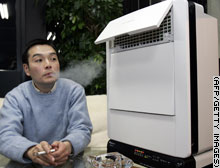|
|
Home | Asia | Europe | U.S. | World | Business | Tech | Science | Entertainment | Sport | Travel | Weather | Specials | Video | I-Reports |
|
|
|
Home | Asia | Europe | U.S. | World | Business | Tech | Science | Entertainment | Sport | Travel | Weather | Specials | Video | I-Reports |
|
By Dana Sullivan Adjust font size:
(Health.com But indoors? Yuck. The air inside your home is two to five times more polluted, according to the Environmental Protection Agency (EPA). And if you suffer from allergies or asthma, spending too much time at home can make you feel worse. Fortunately, you don't need to live in a plastic bubble to solve the problem. Here's how to make your home a (nearly) pollution-free zone. Purify the smart wayDespite big promises, few air purifiers can rid your home of irritants like pollen, dust, and smoke. Don't waste money on devices that don't measure up. Look for purifiers that have: Purifiers fit for the job cost $200 to $500. In recent Consumer Reports testing, the Friedrich C-90B ($499; http://www.amazon.com/ Remember to avoid products with "ion" or "ozone" in their names. James Sublett, M.D., a spokesman for the American College of Allergy, Asthma and Immunology, says none of the ion-generating purifiers he has tested circulate enough air to be effective -- and they all emit some ozone gas. Ozone aggravates asthma and can irritate anyone's upper respiratory system, especially when it interacts with common household cleaners. "There is no such thing as good ozone," Sublett says. "It's bad for you 100 percent of the time." Show your AC some loveUsing the right kind of filter in your heating and cooling system can transform it into a whole-house air cleaner. Your filter should have a Minimum Efficiency Reporting Values (MERV) rating of 11 or 12; the range is 1 to 16. MERV measures the filter's ability to trap tiny particles of pollen, dust, and smoke. The higher the rating, the more efficient the filter. "The right filters remove up to 95 percent of particulates," Sublett says. "Ones that are too porous or dirty just spit stuff back into the house." Disposable filters ($10 to $15) are best, because the reusable kind can breed mold if they're not properly cleaned and dried. Sublett recommends the 3M Filtrete brand, available at home-improvement stores. Most people change these filters less than once a year, but every 3 months is optimal. Mark your calendar, program your PDA, or just sign up for 3M's free e-mail reminders at www.3m.com/us/home_leisure/filtrete/reminder.html Keep your fan onEven when you don't need air conditioning or heat (in early spring or fall, for instance), you still need clean air. A smart solution: Put your AC filter to work by running just the system fan 24-7. Worried about your power bill? Turn the fan off occasionally, open your windows, and inhale the planet's finest. Try some other tricksThe EPA and American Lung Association recommend several no- and low-cost methods to help keep indoor air clean and fresh. For more information, visit www.epa.gov/iaq/pubs/airclean.html or www.healthhouse.org/consumer/tipsheets.asp The please-do-it-now air testAn unsafe level of radon -- an odorless, radioactive gas found in roughly 1 in 15 homes -- is the second-leading cause of lung cancer. Every year it contributes to the deaths of an estimated 20,000 people in the United States, says indoor-air expert Richard Corsi, Ph.D., of the University of Texas at Austin. That's why the American Lung Association says every home should be tested for radon. You can buy a detection kit through your local health department (to find yours, go to www.epa.gov/iaq/whereyoulive.html  Air purifiers fit for the job tend to cost hundreds of dollars. SPECIAL REPORT
RELATED |